On Wednesday night the Historic District Commission reviewed Greenwich Avenue intersection improvements proposed at Havemeyer/Arch and Fawcett/Grigg that were submitted from the Dept of Public Works “to confirm that the MI Plans for the project are in compliance with the existing Greenwich Avenue Historical District listed on the National Register for Historic Places.”
At the start of the three hour meeting, at which about a half dozen members of the public testified, staff member Anne Young said feedback had to relate explicitly to the area’s historic aspect, and not to traffic and parking.
The application was presented by DPW deputy commissioner Jim Michel who listed goals that include improving pedestrian safety, adding parking stalls, building sense of place, increasing green space, and improving accessibility for people with disabilities.
He said the main issue was to better align Arch Street at the intersection of Greenwich Avenue.
Mr. Michel suggested drivers have a sense that they are driving the wrong way up one-way Greenwich Avenue when they travel north from Arch Street to cross over onto Havemeyer.
The plans for this intersection currently includes what has been referred to as a “fly lane” or bypass lane, where cars coming from north on Arch St can veer right and travel south on the Avenue.
Mr. Michel said DPW was open to ideas.
“We’re always open to ideas,” he said. “We’re at the preliminary design phase. Everything you’re seeing here…is very conceptual.”
“Sometimes, we, as engineers, we get the engineering look,” he said.
He said DPW was working with Milone & MacBroom, which he described as an urban planning company.
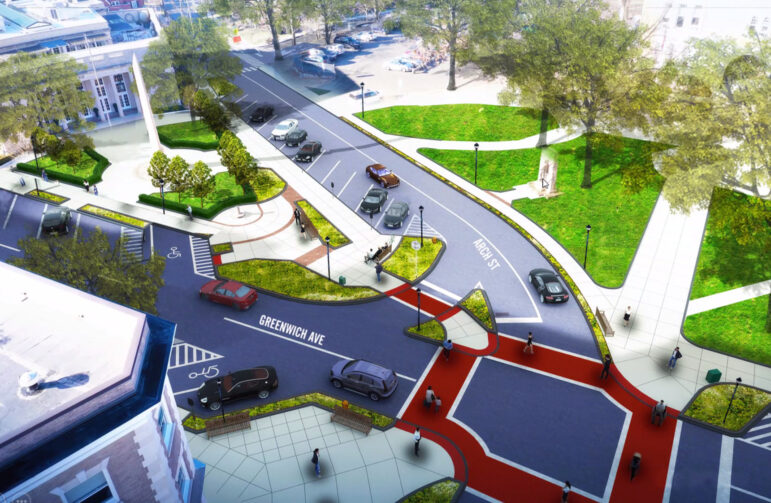
He talked about creating gathering spaces to build a “sense of place” and “neighborhood feel.”
HDC chairman Stephen Bishop said the area with the obelisk and triangle by the historic former post office were currently very well laid out.
“It makes such a statement. It is so beautiful and is so well laid out right now. I think this plan doesn’t do it justice, and really hurts it very much. On that basis alone, I don’t think I can support this plan.”
He said he was torn about the Bolling monument, which would be much closer to a new sidewalk after grass was removed on the Havemeyer lawn in order to shift Arch Street north and better align the intersection.
“It is so beautifully situated right now….Having the thing right on the road…I’m not sure I agree with that,” the HDC chair said. “I think it’s more dignified and has a better setting off the road. In addition, losing so much of that beautiful lawn in front of the Havemeyer building I think is a tremendous loss….We need that kind of green space….That big beautiful lawn is such a treasure.”
Phillip Dodd said he wasn’t bothered by the Bolling monument becoming closer to the sidewalk.
“I think opening it up to the sidewalk is not a bad idea…it just needs to be done very delicately, but I don’t see how that connection can be made without steps, which goes to questions about a retaining wall and level changes…there’s really not enough information in what was presented this evening…”
HDC member Fifi Sheridan said it was important to retain if not enhance the “sanctity and dignity” of the obelisk.
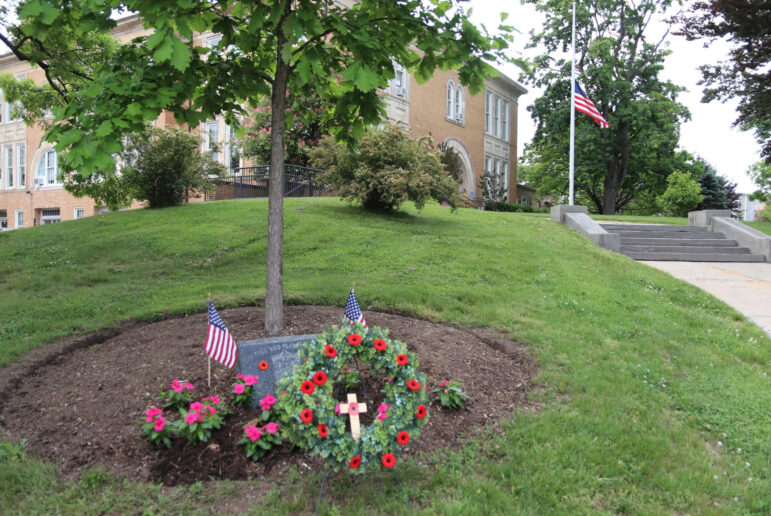
Sheridan said the Civil War monument (which is small and many people are unaware of its existence) should be given the same respect as the larger monuments.
Sheridan talked about the historic significance of the intersection. She said Greenwich did not have a central municipal district until the Havemeyer family donated funds to build the school, which was built on farm land as a meeting house school to accommodate over 700 children.
“That’s why the land is undulating,” she said. “The Havemeyer building was the first monumental building built and it anchored Greenwich. Up until that time the town hall was at the top of the hill in a clapboard building.”
“Then the Bruce siblings donated the funds for the new town hall and Mrs. Havemeyer donated the funds for the post office when her husband passed away. This created central Greenwich. This is the heart of the municipal center.”
“I want to be sympathetic that Greenwich Avenue needs to be repaved, but do we need to do all of this to repave Greenwich Avenue?” she asked.
“Soul of Greenwich”
Commission member Marie Williams said she was a 37 year resident of Greenwich and felt strongly that the intersection was “the soul of Greenwich” and the monuments needed to be treated with great sensitivity.
“With all these historic monuments, it needs to be treated deferentially and with great sensitivity,” she said. “It’s lacking in soul….It’s definitely the soul of Greenwich.”
Later, she said, the idea of abundant planting beds, Williams said historic New England towns being “more reserved,” and generally less “effusive with plantings.”
“The historic nature of this district, in comparison to other New England towns, the point was made that plantings and this sort of refurbishment is not typical of other historic towns,” Williams said, who also asked, “whether the the bump-out approach was appropriate for historic districts, particularly with New England towns.”
“Maybe in California. Maybe in Florida it would resonate better,” Williams said. Williams said her closing comment was: “Parking, parking, parking as being the issue. I have heard in the past few years that vacancy, vacancy in terms of commercial establishments on Greenwich Avenue is also an issue.”
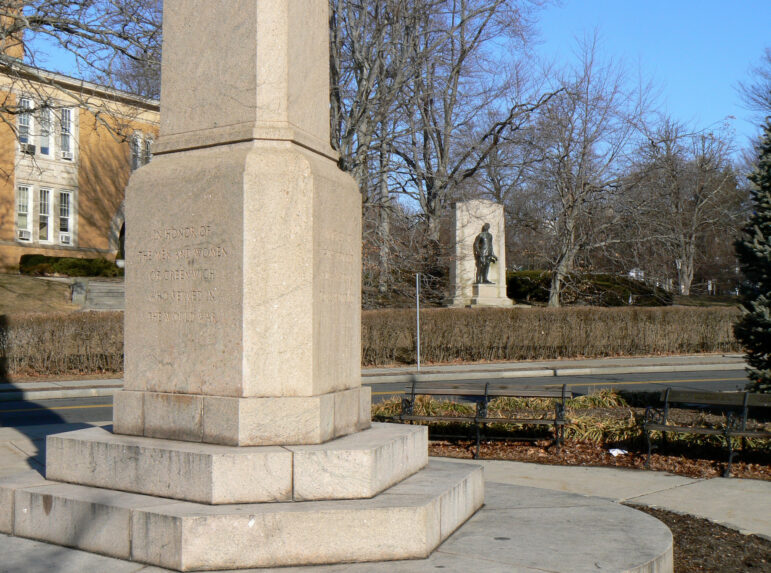
During public comment licensed landscape architect Matt Popp talked about the Bolling memorial being so close to the sidewalk after improvements.
“We’re taking up about 75% of open space buffering. I think you’re going to need steps or a retaining wall,” Popp said. “Just to say that there is no impact – maybe engineering wise – it’s hard to believe somebody could say that.”
Talking about the proposed design of the triangle plaza outside the former post office, he described it as lacking.
“The walks don’t align with anything. They don’t even align with the obelisk. That’s a key thing anybody should realize. There are some pavers proposed, and they look like they’re placed at random. The landscape beds look cluttered. There is no seating. It’s hard to believe that someone actually came up with this design knowing how the town uses this site.”
He said while bumpouts were good in some locations, he didn’t understand the addition of a “bypass” (fly road) through a bump out.
“The overall character is lacking,” he said. “I’ll call it what it is. It’s soulless.” Staff member Ms Young read aloud a letter from Kerry Breed, that said her family had lived in town since the 1960s, and her mother-in-law Rebecca Breed who had passed away the previous week, was Greenwich’s former Selectman and First Selectman.
“She would be shocked to learn that our current First Selectman submitted an application for a grant with erroneous and misleading information designating that there will be no parks or historical structures that will be impacted,” Breed wrote. “This intersection at Havemeyer/Arch Street area has all the following: park area, historical statues, memorial trees, obelisk and designation on the Registry of Historic Municipal areas.”
“It’s important that historical jewel in the center of Greenwich will be destroyed, especially under false pretenses,” Breed concluded in her letter.
During public comment Sheryl Sorbaro said from a historic perspective, the project was not in the best interest of the town.
“I am so opposed to paving over a large area on Arch Street by the historic war monuments for the following reasons: It is unspeakable that bump out construction would ruin the expansive lawn and green space with gorgeous trees to move Arch Street over and up hill,” Sorbaro said. “Also the historical war monument right up against the busy road is just not giving dignity and respect it deserves.”
“In light of the pandemic I think we can all agree that saving green spaces should be a priority. When I look at this plan I see so much pavement and chaos,” Sorbaro continued. “It just doesn’t seem to have the symmetry, and it’s just a real shame.”
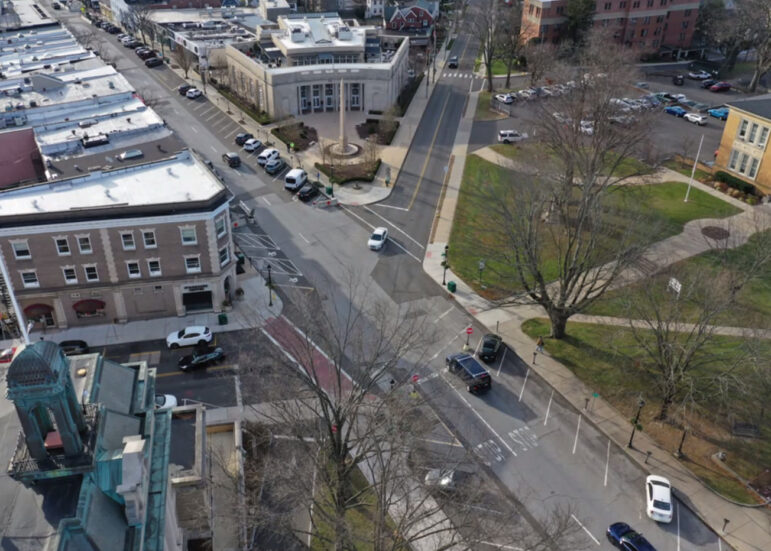
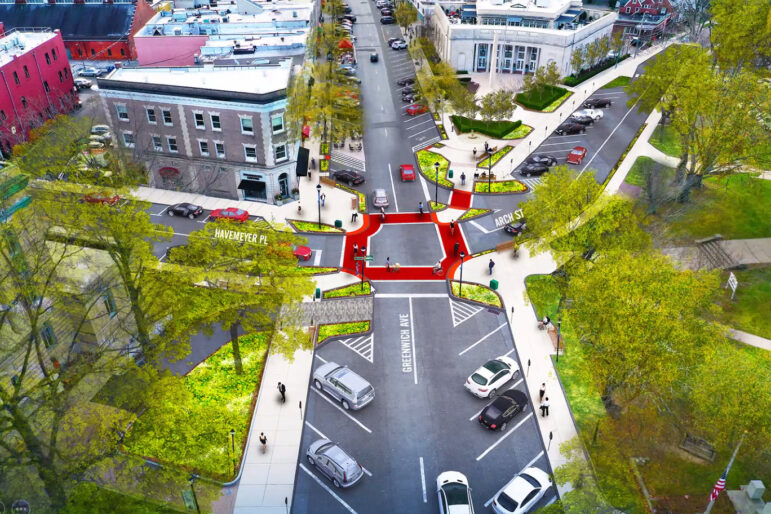
Adopt a Bed Program
Mr. Michel said the curb extensions incorporated in the bump outs provided places for planting beds and went on to talk about ‘adopt a bed’ projects where property owners take over maintenance.
He said the response from the property owner of the building that houses Starbucks, where there would be a plaza with benches, was positive and he could envision working with them.
He said he also anticipated restaurant owners possibly taking over responsibility of maintaining some of the beds.
The commission took a vote on the Havemeyer/Arch intersection.
The motion read:
“The motion for the design as presented does not respect ‘Arch Street/Greenwich Avenue’ must reflect the triangular shape that is present. Further, any provisions that is made by DPW to this plan, obviously concerning planting, seeding, and landscaping, the applicant is asked to come back to HDC to discuss specifics. Further, the HDC supports DPW reaching out to veterans associations on the new approach to the Bolling monument, as well as enter into talks to ensure that the civil war plaque and tree remain and are visible.”
The vote was 8-0 in favor of the motion.
Voting were: Martin Kagan, Philip Dodd, Jenny Larkin, Katie Brown, Marie Williams, Mary Shaw Marks, Fifi Sheridan and Stephen Bishop.
Note: This article was originally published at 9:30am on June 23, but for purposes of the order of the June 24 daily newsletter the time stamp was changed to 9:30pm.